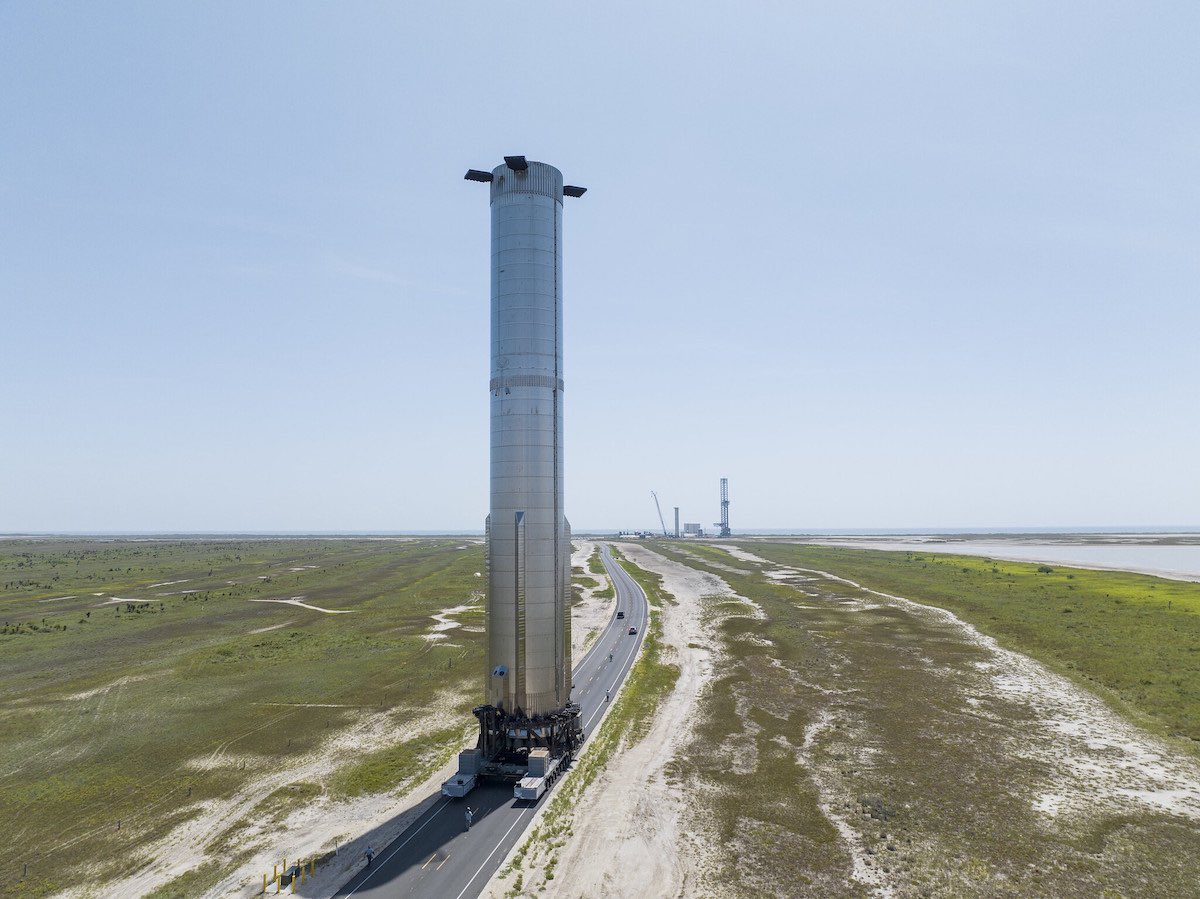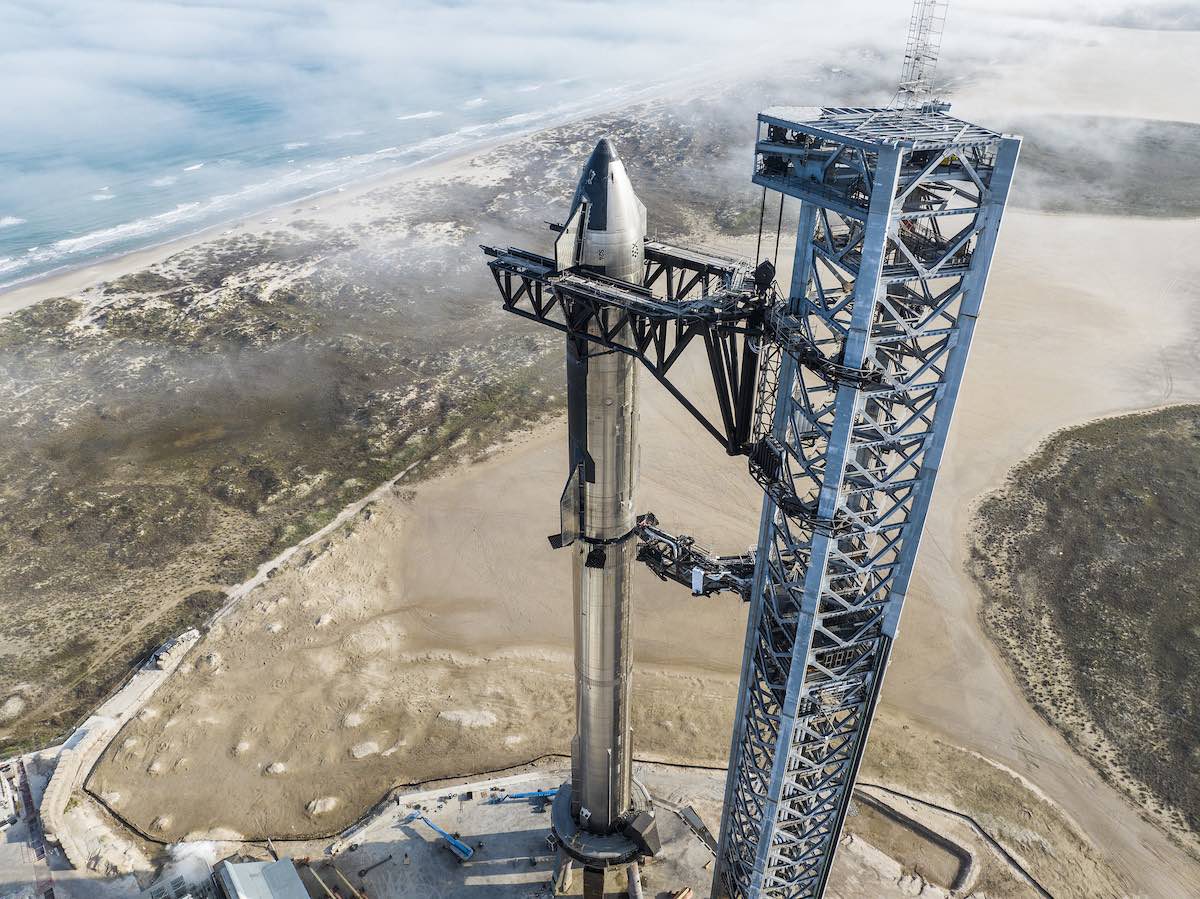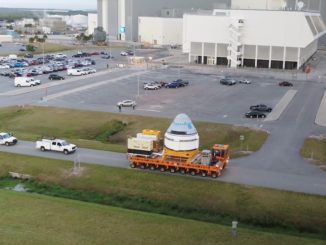
SpaceX is gearing up for the first full-up test-firing Thursday of all 33 engines on the booster for the company’s Starship mega-rocket in Texas, a critical milestone on the path to launching the giant vehicle on its first orbital test flight, which could happen as soon as March if this week’s test goes well.
The long-awaited static fire test will occur at SpaceX’s Starbase facility in South Texas at Boca Chica Beach, located on the Gulf Coast east of Brownsville. Thirty-three methane-fueled Raptor engines will ignite while the Starship’s booster rocket, called the Super Heavy, remains firmly on its launching stand.
SpaceX will load methane fuel and liquid oxygen into the Super Heavy’s tanks during the countdown leading up to the test-firing. If everything looks good, the command will be given to light the 33 Raptor engines mounted in a circular configuration on the bottom of the booster.
“Tomorrow is a big day for SpaceX,” said Gwynne Shotwell, SpaceX’s president and chief operating officer, during the Federal Aviation Administration Commercial Space Transportation Conference Wednesday in Washington.
“We are going to attempt a 33-engine static fire booster test for Starship,” she said, according to Space News. “It’s really the final ground test that we can do before we light ‘em up and go.”
The 33 Raptor engines can generate more than 16.5 million pounds of thrust at full power. It’s not known if the test-firing in South Texas will be at full thrust.
If the test-firing goes well, SpaceX could be in a position to attempt the first Starship orbital test flight in March, Shotwell said.
“That first flight test is going to be really exciting. It’s going to happen in the next month or so,” she said.
“We will go for a test flight and we will learn from the test flight and we will do more test flights,” Shotwell said. “The real goal is to not blow up the launch pad. That is success.”
SpaceX fired 14 of the Super Heavy booster’s engines on the launch pad in November. Teams rolled the Super Heavy booster — numbered Booster 7 in SpaceX’s nomenclature — back to the company’s nearby production facility for repairs and upgrades before returning it to the pad. Ground crews fully stacked the Super Heavy and Starship vehicle on the Starbase launch pad for a wet dress rehearsal, or fueling test, last month.
The Starship vehicle — essentially part upper stage and part in-space transporter — will not be attached to the top of the Super Heavy booster for the 33-engine ground test this week. The Starship itself has six Raptor engines to power itself into orbit after separating from the Super Heavy booster a few minutes after liftoff.
The booster alone stands 226 feet, or 69 meters, tall, about the same height as SpaceX’s fully assembled Falcon 9 rocket.
SpaceX’s huge privately-funded rocket, made of shiny stainless steel, will be the most powerful ever to fly. The thrust from the 33 main engines on the first stage will double the power output of NASA’s Saturn 5 moon rocket and the Space Launch System, which took the title of most powerful rocket currently flying when it launched on the Artemis 1 lunar test flight in November.
And both stages of the Starship launch vehicle are designed to be fully reusable, a step forward from SpaceX’s partially reusable Falcon 9 and Falcon Heavy rockets, which require brand new upper stages on each flight. SpaceX is targeting 100 launches of its Falcon rocket family this year, after logging a record 61 launches last year.

SpaceX’s concept for recovering the Super Heavy booster involves catching it with articulating “chopstick” arms on the launch tower. The Starship will also use its engines to return through the atmosphere and land back on Earth, or reach the surfaces of other planetary bodies like the moon or Mars. The first Starship orbital test flight, however, will not include any recovery and reuse attempts.
“SpaceX’s Starship spacecraft and Super Heavy rocket – collectively referred to as Starship – represent a fully reusable transportation system designed to carry both crew and cargo to Earth orbit, the moon, Mars and beyond,” SpaceX says on its website. “Starship will be the world’s most powerful launch vehicle ever developed, with the ability to carry up to 150 metric tonnes to Earth orbit reusable, and up to 250 metric tonnes expendable.”
The Starship’s first orbital test flight, though audacious in scale, will aim to prove out the rocket’s basic launch and re-entry capabilities without fully testing out the complicated landing and recovery systems, according to a SpaceX filing with the Federal Communications Commission last year.
On the first orbital mission, SpaceX plans for the Starship to re-enter the atmosphere after one trip around Earth, heading for a controlled landing at sea in the Pacific Ocean near Hawaii. The Super Heavy booster will splash down in the Gulf of Mexico.
“Success is far from certain, but excitement is guaranteed,” Elon Musk, SpaceX’s founder and CEO, tweeted earlier this week.

The FAA announced last year that it will require SpaceX to take more than 75 actions to reduce the environmental effects of flying its 40-story-tall Starship rocket from South Texas. But not all of the mitigation steps are required before the FAA issues a commercial launch license to SpaceX for the first Starship orbital test flight.
“We’ve been working all the mitigations,” Shotwell said Wednesday. “I think we’ll be ready to fly right at the timeframe that we get the license.”
SpaceX wants to use the Starship vehicle to launch the company’s Starlink internet satellites, flying heavier, next-generation versions of the broadband relay stations than the spacecraft now being launched by the smaller Falcon 9 rocket. An animation released from SpaceX showed the company’s concept for deploying Starlink satellites from a Starship vehicle in orbit, using a mechanism that works like a giant Pez dispenser.
SpaceX has also won a $2.9 billion contract with NASA to develop the Starship into a human-rated lander for the agency’s Artemis moon missions. A moon derivative of the Starship, assisted by Starship refueling tankers, will be utilized for a lunar landing with astronauts, an event NASA says could happen no earlier than 2025. SpaceX also has a deal with Japanese billionaire ,Yusaku Maezawa to send a team of private citizens around the moon on a Starship flight.
Flights of the Starship beyond low Earth orbit will require the still-untested in-orbit refueling capability SpaceX is developing for the new-generation rocket.
Musk has said SpaceX intends to use the Starbase facility in Texas as a test site for the Starship program. The company is building a second Starship launch pad at NASA’s Kennedy Space Center in Florida, with plans to construct more launch sites in the future, eventually building up to a capability to launch multiple Starship flights per day. With rapid reuse, SpaceX aims to reduce costs and give customers unprecedented access to space.
“We have Starship be as much like aircraft operations as we can possibly can get it,” Shotwell said, according to Space News. “We want to talk about dozens of launches per day, if not hundreds of launches a day.”
Email the author.
Follow Stephen Clark on Twitter: @StephenClark1.



